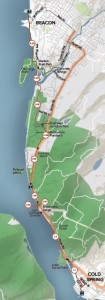State funds part of Fjord Trail Project
By Kevin E. Foley
Proponents of the Fjord Trail, a planned hiking and biking pathway running along the Hudson River between Cold Spring and Beacon, received an early holiday present yesterday (Dec. 11) when Governor Andrew Cuomo announced a new round of economic development grants, including $935,000 for the project.
The funding is part of Cuomo’s Regional Business Council initiative wherein locally created projects intended to increase economic activity and increase job opportunities are provided with seed money from the state government. In this round of grants 852 projects received funding for a total of $709.3 million.

Advocates for the Fjord Trail include all the local governments that encompass the area the path would traverse including the towns of Philipstown, Fishkill, the city of Beacon and the Village of Cold Spring. Scenic Hudson, the regional nonprofit land preservation and environmental protection group is also a major driver of the project.
Still in the design stage, the Fjord Trail will ultimately cost several million dollars. This fresh round of funding will allow for progress on what many consider a critical feature of the project, the creation of a safer, more orderly way for visitors arriving by car and train to access hiking trails in Philipstown and Fishkill along the Route 9D corridor, including the popular destination Breakneck Ridge. Currently cars are often parked along the edges of 9D with pedestrians walking along the roadway perilously close to traffic.
According to the grant announcement, the money is intended to help create a new visitor features for the Hudson Highlands State Park area at Little Stony Point just north of Cold Spring, improved train access and better parking for both cars and bicycles in and around the whistle-stop Breakneck Ridge train platform as well as an ADA-accessible path to the Breakneck Ridge trail head. Additional traffic signage along 9D is also planned.
“Even though hikers are entering a state park it doesn’t look like one,” said Jeff Anzevino, director of land use advocacy for Scenic Hudson. “We want to see it [9D] look and feel and function like a parkway more than just a two-lane highway.” Anzevino said his organization is taking a lead role in organizing the project because it has the necessary professional planning staff local governments lack. He stressed that it is very much a cooperative and coordinated venture that also includes officials from Metro North, the New York State Departments of Parks and Recreation and Transportation each of which will oversee work on their agencies’ property.
Anzevino said Scenic Hudson sees the Fjord Trail project as part of the larger tourism and recreation theme for the economic benefit of the region and that it would be an important part of the effort to connect residents and visitors to the various parks within the Hudson Valley.
This year the Mid-Hudson region received the most money totaling $82.8 million for projects among the eight designated regions of the state. Locally the Hudson Valley Shakespeare Festival obtained a $71,000 grant for education and outreach projects intended to encourage access and participation in the arts. Manitoga Inc., the home of designer Russel Wright in Garrison also received a $16,700 grant for a large sculpture project.


Congrats to all the many many folks who have been diligently working on this project! A great example of a public/private partnership that benefits us all.
OK I have to comment here. While I agree multi-faceted improvements are needed and long overdue, for this section of 9D, for access to/from the train system, and for facilities of all kinds to/from and within the park system, the state’s driving principle should not be a support of “locally created projects intended to increase economic activity and increase job opportunities.”
Firstly, this is a state park, a state highway, and a train system in great part managed by the state. Improvements should not be dependent upon, nor designed to enhance ‘locally created projects.’ (I realize the state was asleep and did almost nothing until the local municipalities organized and created, but that is not the way it ought to be.)
Secondly, the intent and primary purpose of state activity for improvements to a state park system should not be to “increase economic activity.” State parks are purposed for the rest and recreation of the residents of the state and visitors. Rest is the antithesis of economic activity.
This state government needs to take full and direct responsibility for the state park system, including improvements, park staffing, safety, rescue, fire prevention, access, information, ecology, and preservation. Alternatively, it may hand this particular Hudson Highlands park over to a regional authority and stop calling it part of the state system. But the latter concept is fraught with its own challenges and hazards.
Thirdly, in reference to “better parking for both cars and bicycles in and around the whistle-stop Breakneck Ridge train platform,” while improvements to the existing parking spaces ought to be made, to the extent that they can be made safe (currently they are far from safe, in many places, and particularly in and around the highway tunnel) there is a limit beyond which space for better or more parking is possible. That limit is determined by the landscape, the topography, and the existence and demands of the state highway itself. Other methods of access and transportation need to be pursued.
Lastly, I am puzzled by the idea of “an ADA-accessible path to the Breakneck Ridge trail head.” Just how far is ADA accessibility going to be possible? The trail itself cannot be made ADA accessible. as far as I know. Perhaps only as far as a view point or a visitors center. Maybe this part of the improvement plan is under reported or still to be determined.
I think this grant is great news! Can’t wait to see the changes as they occur. And big thanks to all who worked hard to make this happen.